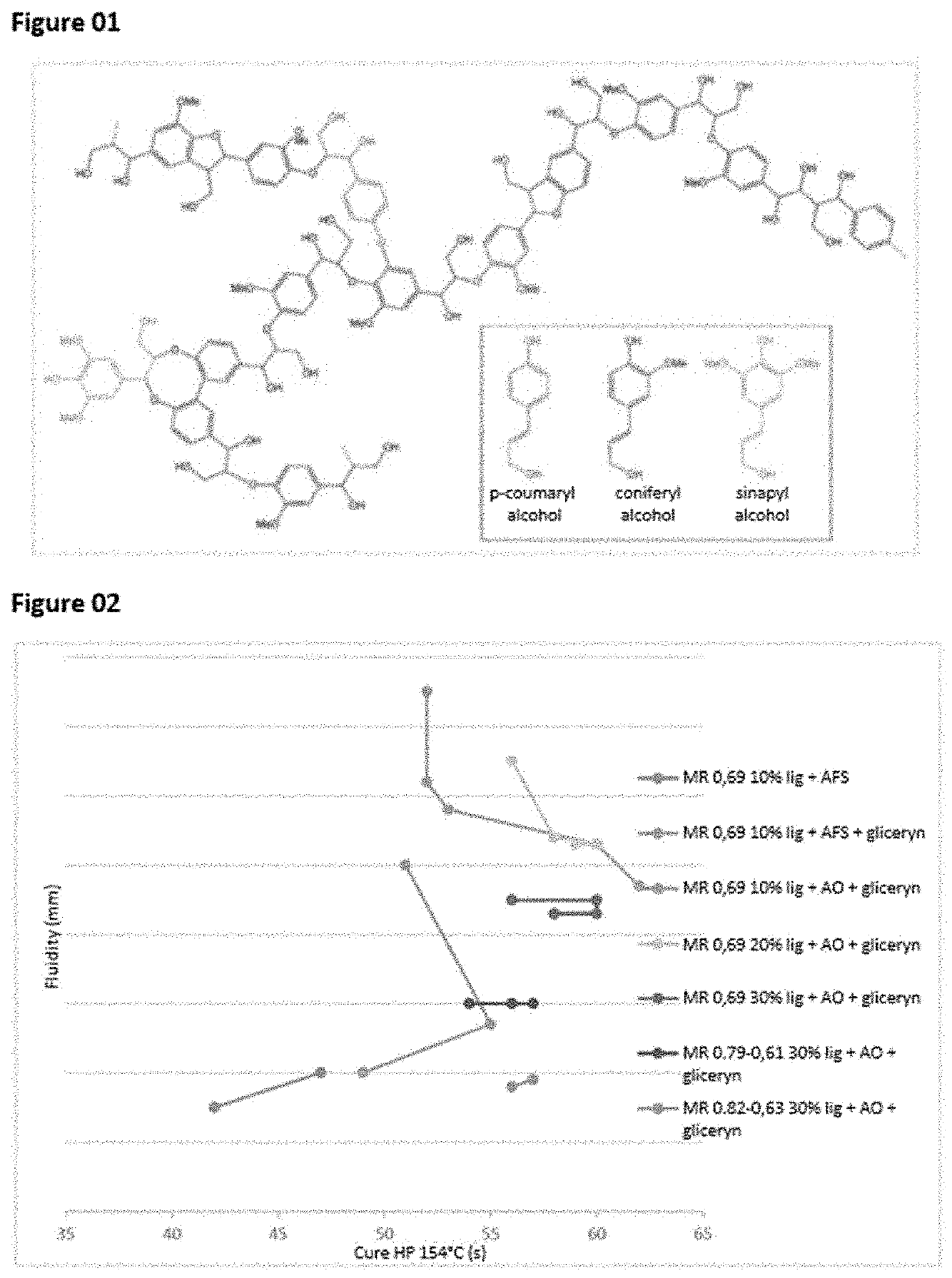Novolac phenolic resins, process of synthesis of said phenolic resins and use thereof
- Summary
- Abstract
- Description
- Claims
- Application Information
AI Technical Summary
Benefits of technology
Problems solved by technology
Method used
Image
Examples
example 1
[0169]In this example, a novolac-type phenolic resin synthesis process according to the present invention is described with the addition of 30% lignin with respect to the mass of phenol used. To obtain a novolac-type phenolic resin according to the present invention, the following process can be employed:
[0170]a) dissolving 390 grams of lignin in 1,300 grams of phenol, at a temperature of 60° C.;
[0171]b) adjusting the pH value to 1.3 with oxalic acid / water;
[0172]c) adding 20 grams of formalin at a temperature of 67.6° C.;
[0173]d) adjusting the temperature to 100° C., to start reflux at atmospheric pressure;
[0174]e) adding 602 grams of formalin, under reflux;
[0175]f) condensating the obtained product, still under reflux, at a temperature ranging from 99, 2 to 99.7° C., until an amount of less than 1.0% of free aldehyde is present in the reflux water;
[0176]g) distilling the obtained product under atmospheric pressure until a temperature of 150° C. is reached;
[0177]h) applying a vacuum...
example 2
[0180]In this example, a novolac-type phenolic resin synthesis process according to the present invention is described with the addition of 50% lignin with respect to the mass of phenol used. To obtain a novolac-type phenolic resin according to the present invention, the following process can be employed:
[0181]a) Dissolving 500 grams of lignin in 1,000 grams of phenol, at a temperature of 70° C.;
[0182]b) adjusting the pH value to 1.3 with phenolic sulfonic acid;
[0183]c) adding 15 grams of formalin at a temperature of 70° C.;
[0184]d) adjusting the temperature to 100° C., to start reflux at atmospheric pressure;
[0185]e) adding 381 grams of formalin, under reflux;
[0186]f) condensating the obtained product, still under reflux, at a temperature ranging from 98 to 99° C., until an amount of less than 1.0% of free aldehyde is present in the reflux water;
[0187]g) distilling the obtained product under atmospheric pressure until a temperature of 150° C. is reached;
[0188]h) applying a vacuum o...
example 3
[0191]This study evaluates the properties of the phenolic resin obtained through the process of example 1 in which there was an addition of 30% of lignin with respect to the mass of phenol used.
[0192]The components applied in the phenolic resin synthesis process of the present study are shown in Table 1 below:
TABLE 1ComponentWeight (g)Phenol1,300Lignin390Oxalic acid16Water16Formalin 50% (1) * 20Formalin 50% (2) **602* First addition of formalin.** Second addition of formalin.
[0193]In Table 2, properties of the phenolic resin obtained by means of the present invention process are indicated, in which the components were applied in the amounts expressed in Table 1.
TABLE 2Property of the obtained resinResultFluidity18 mmCure HP 154° C.75″Capillary melting point80° C.Solubility in methanolSolubleSolubility in ethanolSoluble
[0194]With the present study, it was concluded that it was possible to synthesize a novolac-type phenolic resin with the addition of kraft lignin having specifications...
PUM
| Property | Measurement | Unit |
|---|---|---|
| Temperature | aaaaa | aaaaa |
| Temperature | aaaaa | aaaaa |
| Temperature | aaaaa | aaaaa |
Abstract
Description
Claims
Application Information
 Login to View More
Login to View More - R&D
- Intellectual Property
- Life Sciences
- Materials
- Tech Scout
- Unparalleled Data Quality
- Higher Quality Content
- 60% Fewer Hallucinations
Browse by: Latest US Patents, China's latest patents, Technical Efficacy Thesaurus, Application Domain, Technology Topic, Popular Technical Reports.
© 2025 PatSnap. All rights reserved.Legal|Privacy policy|Modern Slavery Act Transparency Statement|Sitemap|About US| Contact US: help@patsnap.com

